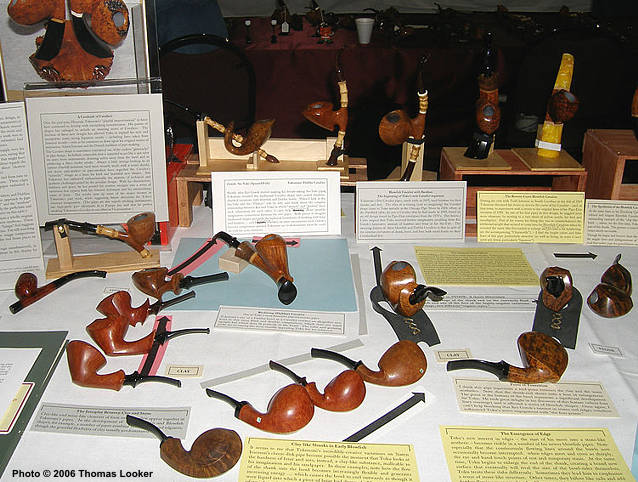
CHICAGO PIPE SHOW - May 2006
THE IMAGINATIVE
EVOLUTION OF HIROYUKI TOKOTOMI
Exhibit Page 2
THE EXHIBIT: Section by Section
1. Theory
|
Preamble: tOKU'S "Clay" and "Stone" Styles ? An hypothesis |

|
Clay and Stone: Two Styles of Organic Design? Tokutomiís pipes have always been characterized by a unique sense of organic design, in which Tokuís Japanese aesthetics (including, most importantly, his use of asymmetrical balance) create shapes which seem in constant motion: our eyes and hands move continuously over the shanks and bowls, flowing easily and endlessly around the twists and turns of line, texture, and grain. One of my first responses to Tokutomiís work was to marvel at how much he made the wood seem like clay Ö whose pliable substance had gently yielded to his fingers, even as my fingers could now retrace his original gestures across the briar. In one of our first conversations, when I commented on how wonderfully supple were his carvings, Toku expressed a traditional Japanese aversion to straight lines, saying that as he was working on a pipe, he would always "correct" any straight lines that appeared, turning them into curves. (I believe that traditional Japanese culture regards the indirect, curved line as more "natural," and hence beautiful, than the direct "shortest-distance-between-two-points" paradigm that human tools [and Western sensibilities] so often produce). But Tokutomi always seems ready to challenge himself with new ideas and from time to time he experimented with overtly straight lines in his compositions. Characteristically, Toku juxtaposed these distinct edges with softer, more flexible forms, so some of his pipes embodied a heightened sense of tension (and a slightly more assertive energy). Iíve always wondered how much Tokuís use of the ridge in his blowfish, sitters, and Dublins reflected the influence of his friend and "student," Kei Gotoh, whose approach to pipe design has usually mixed the curved and the straight, the "traditional" and the "modern" Japanese traditions. (The tone of Gotohís pipes often seems to embody the perfection and intensity of gems in all their brilliance and beauty. See my notes elsewhere in this exhibit. [towards the bottom of page 6]) In his most recent compositions, however, Toku has broken through into a wholly original range of improvisations, merging the curved and the straight in a new synthesis. These pipes have many hard, irregular edges and shapes, but their organic, "lumpy" feel suggests to me neither pliable clay nor the perfect immutability of polished gems. Iím still searching for appropriate language here, but my first response is that these craggy compositions resemble rough-hewn stone. (I list the characteristics of Tokuís Clay and Stone pieces in another note [bottom of page 5].) At the moment, Tokutomi is pursuing both lines of organic design simultaneously, in different pipes. I present a variety of Clay and Stone compositions in this display for viewers to contemplate. |
|
The Interplay Between Clay and Stone Clay-like and stone-like elements of form and line often appear together in Tokutomiís pipes. In the development of Tokuís Dublin and Blowfish shapes, for example, a number of pipes combine both fluidity and edginess, though the graceful flexibility of clay usually predominated. |
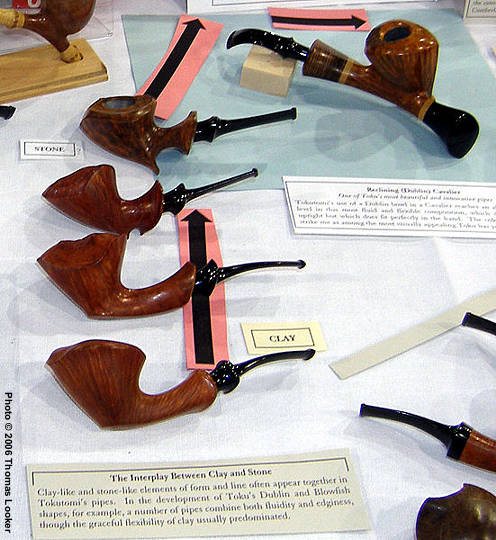
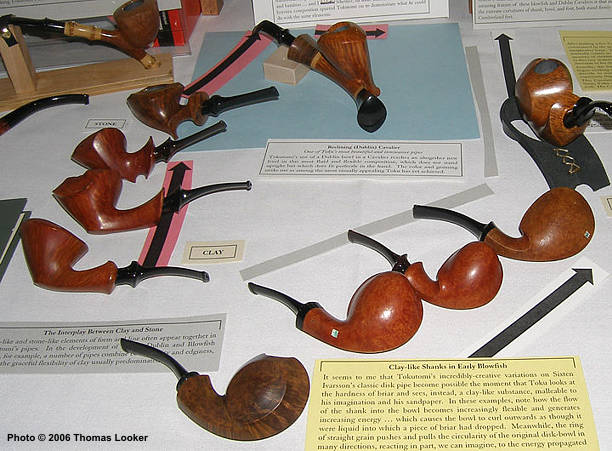
|
Clay-like Shanks in Early Blowfish It seems to me that Tokutomiís incredibly creative variations on Sixten Ivarssonís classic disk pipe become possible the moment that Toku looks at the hardness of briar and sees, instead, a clay-like substance, malleable to his imagination and his sandpaper. In these examples, note how the flow of the shank into the bowl becomes more flexible and generates increasing energy Ö which causes the bowl to curl outwards as though it were muddy water into which a piece of briar had dropped. Meanwhile, the ring of straight grain pushes and pulls the circularity of the original disk-bowl in many directions, reacting in part, we can imagine, to the energy propagated into the bowl by the flow of the shank. |
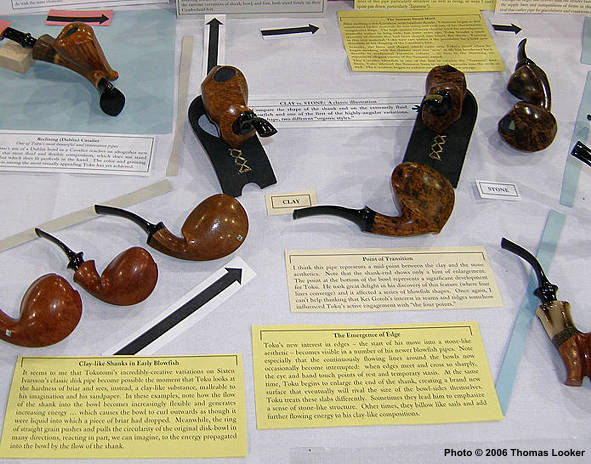
|
The Emergence of Edge Tokuís new interest in edges Ė the start of his move into a stone-like aesthetic Ė becomes visible in a number of his newer blowfish pipes. Note especially that the continuously flowing lines around the bowls now occasionally become interrupted: when edges meet and cross so sharply, the eye and hand touch points of rest and temporary stasis. At the same time, Toku begins to enlarge the end of the shank, creating a brand new surface that eventually will rival the size of the bowl-sides themselves. Toku treats these slabs differently. Sometimes they lead him to emphasize a sense of stone-like structure. Other times, they billow like sails and add further flowing energy to his clay-like compositions. |
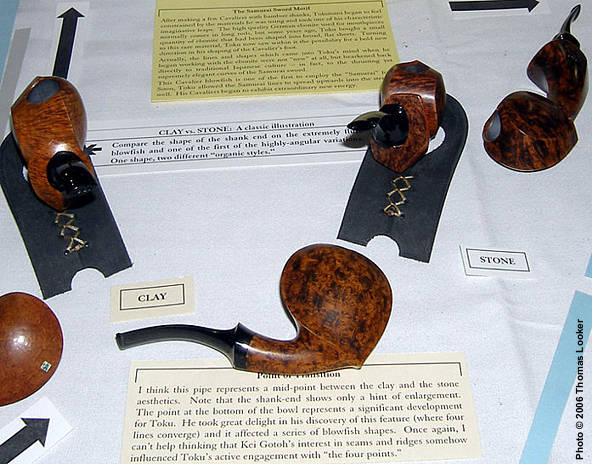
|
Point of Transition I think this pipe represents a mid-point between the clay and the stone aesthetics. Note that the shank-end shows only a hint of enlargement. The point at the bottom of the bowl represents a significant development for Toku. He took great delight in his discovery of this feature (where four lines converge) and it affected a series of blowfish shapes. Once again, I canít help thinking that Kei Gotohís interest in seams and ridges somehow influenced Tokuís active engagement with "the four points." |
|
CLAY vs. STONE: A classic illustration Compare the shape of the shank end on the extremely fluid blowfish and one of the first of the highly-angular variations. One shape, two different "organic styles." |
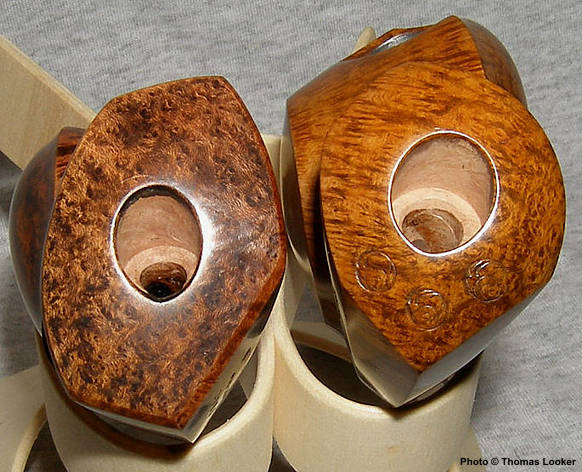
Another STONE example ("Deconstructed Blowfish"):
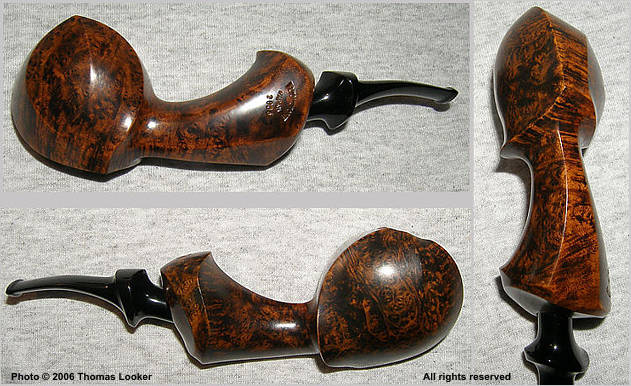
We can see both "Clay" and "Stone" styles throughout Toku's development of his cavalier pipes ... beginning on the next page.
END OF EXHIBIT PAGE 2